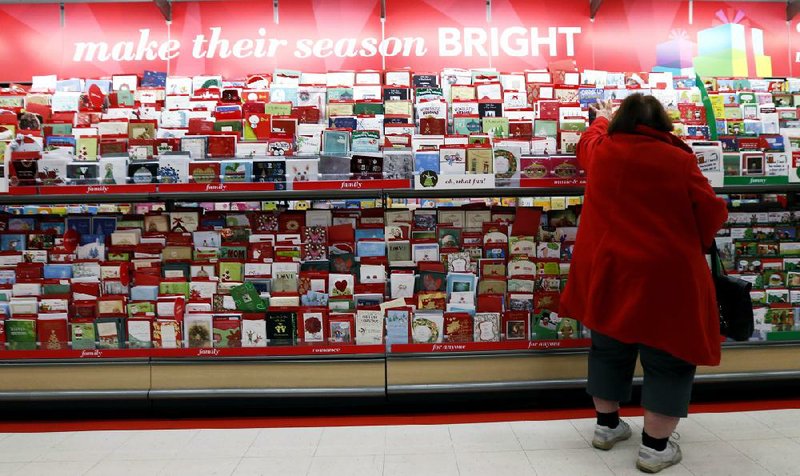WASHINGTON — Shoppers spent cautiously this Christmas, a disappointment for retailers who slashed prices to lure people into stores and now must hope for a post-holiday spending burst.
Sales of electronics, clothing, jewelry and home goods in the two months before Christmas increased 0.7 percent compared with last year, according to the MasterCard Advisors SpendingPulse report released Tuesday.
That was below the healthy 3 percent to 4 percent growth that analysts had expected - and it was the worst year-over-year performance since 2008, when spending shrank sharply during the recession. In 2011, retail sales climbed 4 percent to 5 percent during November and December, according to ShopperTrak.
This year’s shopping season was marred by bad weather and rising uncertainty about the economy in the face of possible federal tax increases and spending cuts early next year. Some analysts say the massacre of schoolchildren in Newtown, Conn., earlier this month may also have chipped away at shoppers’ enthusiasm.
Retailers still have time to make up lost ground. The final week of December accounts for about 15 percent of the month’s sales, said Michael McNamara, vice president for research and analysis at MasterCard Advisors SpendingPulse. Spending-Pulse tracks total U.S. sales at stores and online via all payment forms.
Still, this season’s weak sales could have repercussions for 2013, McNamara said. Retailers will make fewer orders to restock their shelves, and discounts will hurt their profitability. Wholesalers will buy fewer goods, and orders to factories will likely drop in the coming months.
Steep discounts weren’t enough to get people into stores, said Marshal Cohen, chief analyst at the market research firm NPD Inc.
“A lot of the Christmas spirit was left behind way back in Black Friday weekend,” Cohen said, referring to the traditional retail rush on the day after Thanksgiving. “We had one reason after another for consumers to say, ‘I’m going to stick to my list and not go beyond it.’”
Holiday sales are a crucial indicator of the economy’s strength. November and December account for up to 40 percent of annual sales for many retailers. If those sales don’t materialize, stores are forced to offer steeper discounts. That’s a boon for shoppers, but it cuts into stores’ profits.
Spending by consumers accounts for 70 percent of overall economic activity, so the eightweek period encompassed by the SpendingPulse data is seen as a critical time not just for retailers but for manufacturers, wholesalers and companies at every other point along the supply chain.
The SpendingPulse data released Tuesday, which captures sales from Oct. 28 through Dec. 24, is the first major snapshot of holiday retail sales. A clearer picture will emerge next week as retailers like Macy’s and Target report revenue from stores open for at least a year. That sales measure is widely watched in the retail industry because it excludes revenue from stores that recently opened or closed, which can be volatile.
Consumer confidence fell in December to a five-month low, according to a Dec. 21 report. The Thomson Reuters/University of Michigan consumer sentiment index slid to 72.9, the weakest since July, from 82.7 in November.
In the run-up to Christmas, analysts blamed bad weather for putting a damper on shopping. In late October, superstorm Sandy battered the Northeast and mid-Atlantic states, which account for 24 percent of U.S. retail sales.
Shopping over the past two months was weakest in areas affected by Sandy and a more recent winter storm in the Midwest. Sales declined by 3.9 percent in the mid-Atlantic and 1.4percent in the Northeast compared with last year. They rose 0.9 percent in the north-central part of the country.
The West and South posted gains of between 2 percent and 3 percent, still weaker than the 3 percent to 4 percent increases expected by many retail analysts.
Luxury sales “struggled,” pulled down by the New York region, which generates 20 percent of that category’s U.S. sales and was hit hard by the hurricane, McNamara said.
Apparel and consumer electronics sales performed in line with the national average, he said.
The only bright spot was home-related merchandise, which benefited from the housing rebound, he said.
Retailers “sabotaged” themselves by not offering greater discounts in the three days before Christmas, Burt Flickinger, managing director of Strategic Resource Group in New York, said today in an interview with Bloomberg Radio.
“Instead of having 50 to 70 percent off that the retailers had on Black Friday, it was buy one, get 50 percent off,” Flickinger said. “Shoppers didn’t see the bargains. And the shoppers are bypassing the shopping center, mall-based stores to shop at Amazon.com and other online providers.”
Online sales, typically a bright spot, grew only 8.4 percent from Oct. 28 through Saturday, according to SpendingPulse. That’s a dramatic slowdown from the online sales growth of 15 percent to 17 percent seen in the previous 18-month period, according to the data service.
Online sales did enjoy a modest boost after the recent snowstorm that hit the Midwest, McNamara said. Online sales make up about 10 percent of total holiday business.
Shopping picked up in the second half of November, but then the threat of the country falling off a “fiscal cliff” gained strength, throwing consumers off track once again.
Lawmakers have yet to reach a deal that would prevent tax increases and government spending cuts set to take effect at the beginning of 2013. If the cuts and tax increases kick in and stay in place for months, the Congressional Budget Office says the nation could fall back into recession.
Information for this article was provided by Cotten Timberlake of Bloomberg News.
INTERACTIVE GRAPHIC
Business, Pages 21 on 12/27/2012

